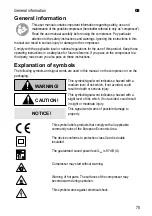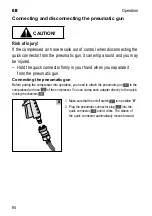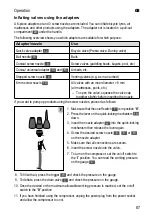
GB
Safety
81
Notes for hoses and pneumatic tools
–
Do not operate the compressor if it has any defects which could
endanger the operator or third parties.
–
Check the compressor for rust and damage before each use. Do not
operate the compressor if it is damaged or deformed. If you notice
any damage, immediately seek advice from our customer service
department at the service address.
–
Do not loosen any connections while the compressor is under pressure.
–
Make sure that the compressed air vessel is always vented before
disconnecting connections, connecting pneumatic tools or dismantling.
–
Make sure that you only use pneumatic lines for compressed air which
are suitable for at least 150% of the compressor's maximum pressure.
–
Do not use the compressor if the hoses or the hose connections are
leaky or damaged.
–
Do not try to repair damaged lines, but instead replace them.
–
Ensure that hose clamps are always tight. Loose or damaged hose
clamps can cause uncontrolled escape of air.
–
Do not touch the compressor and hoses during operation in order to
avoid burns.
–
Be very careful when working.
Instructions for installation and mains connection
–
Only use the compressor indoors.
–
Place the compressor on an easily accessible, flat, dry and
adequately stable surface. Do not place the compressor on or near
the edge of a work surface.
–
During operation always place the compressor on its base.
–
Do not place the compressor on or near hot surfaces.
–
Place the compressor in a location with clean and dry air. Do not use
it in damp rooms and work areas where water might be sprayed, or in
the rain.
–
Only connect the compressor to a power socket whose mains voltage
corresponds to the operating voltage on the type plate.
Содержание 5404300
Страница 2: ...Dok Rev Nr 194792_01_20170330 2 ...
Страница 3: ...3 Übersicht A 1 11 2 3 4 6 7 8 9 10 12 13 14 15 16 17 18 5 20 19 ...
Страница 48: ...CZ 48 ...
Страница 72: ...F 72 ...
Страница 138: ...PL 138 ...
Страница 159: ...159 Konformitätserklärung Konformitätserklärung ...
















































